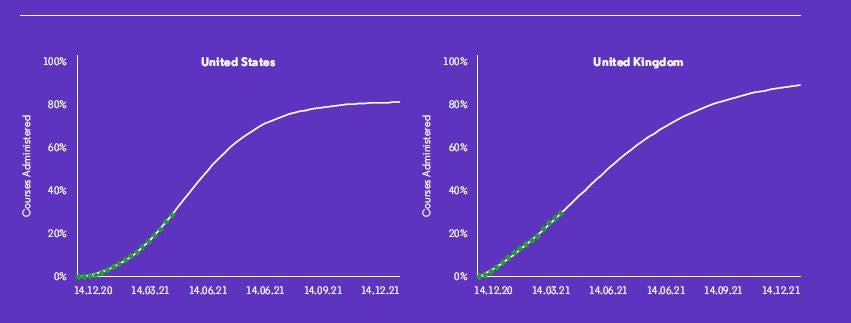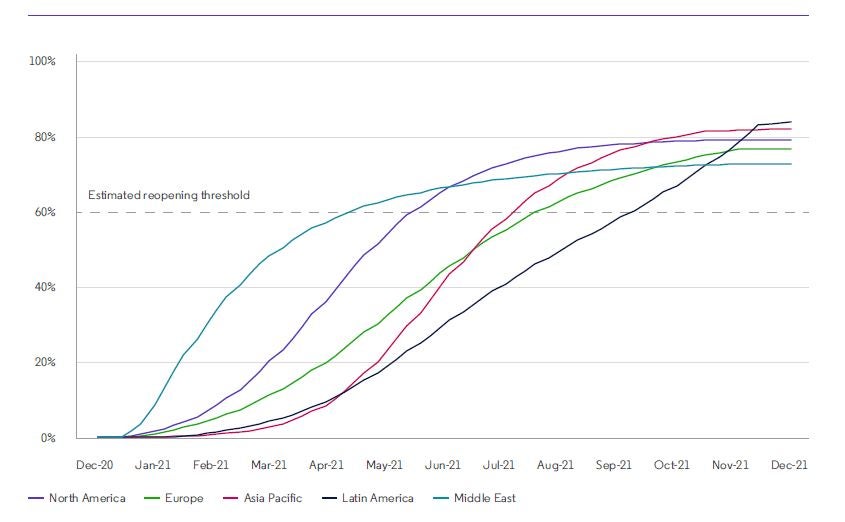COVID-19 vaccination represents a critical component in the recovery of medtech markets for healthcare capacity, patient mobility and the full restoration of global manufacturing operations and supply chains. To understand the effect of various vaccination campaigns, we need to understand the rollout by region and country.
Clarivate experts developed a vaccination forecast model to illustrate how regional vaccine rollout will impact recovery for medtech markets. This article is an excerpt of the COVID-19 vaccine availability and medtech impact report.
One of the key components to the recovery of the healthcare industry is COVID-19 vaccination. However, as we’ve seen since the first vaccine received emergency approval in December 2020, vaccine rollout has not been consistent within a country, let alone worldwide. Wealthier countries quickly purchased large supplies of vaccines, often more than needed for their own population size, while low-income countries have been left to wait for doses to become available through multilateral vaccine initiatives like COVAX. However, some countries have committed to sharing surplus doses once their populations reach sufficient vaccination levels.1-4
Based on secured purchasing deals as of April 16, 2021, 85% of vaccine doses will be going to high-income countries, 14% to middle-income countries (12% to upper middle income) and only 1% to low-income countries through COVAX.5
Here, we discuss the methodology and data Clarivate analysts used to determine how vaccination campaigns will roll out by region and country to better determine how the recovery in different markets may proceed.
Forecasting vaccination rollout
Using data around COVID-19 cases and infection rates, hospital capacity and utilization, vaccination rates and population mobility, combined with existing Clarivate data and expertise, we built a top-down model that forecasts vaccination rollouts across different countries. This reveals several insights, such as the timing of when certain populations may become vaccinated or the ability of a country to distribute vaccines.
For key influences upon the effectiveness of both vaccination rollout and uptake by region, please see our deck “COVID-19 vaccine rollout: Key concepts and regional breakouts.”
Inputs and methodology
Clarivate analysts used real world data for a country’s current COVID-19 vaccination rates as a baseline to develop a forecast for the 52 weeks after a country starts its vaccination program. Once a country has more than six weeks of vaccination data, they fit a forecast line to the existing data and then used to determine to the forecast for the remaining 46 weeks.
They chose a logistic S-curve as the model type for the forecast line. The characteristics of a logistic function include a slow beginning that evolves into exponential growth and eventually reaches a plateau. Such functions provide a more sophisticated representation of population-based data than a simple linear or exponential function.
We included country-specific parameters to capture real world limitations and conditions, including:
- Maximum vaccine acceptance: how many people in a country are willing and intend to receive a COVID-19 vaccine (See our deck “COVID-19 vaccine rollout: Key concepts and regional breakouts.”)
- Maximum distribution capacity: the largest number of doses that can be administered per week
- Maximum ramp-up rate: how much vaccine distribution can expand each week
In addition, they used data from Clarivate epidemiology specialists to inform at-risk demographics, including the elderly, those with one or more co-morbidities and front-line healthcare workers. By applying these parameters to a logistic curve that best fit the existing data, analysts developed a forecast for each country’s vaccine rollout, which can be updated on a quarterly basis. They used government vaccination targets to visualize and track countries’ vaccination campaign performance.
Limitations
They assumed that a fully completed vaccine course requires two doses; however, analysts are working to add components that can account for single-dose vaccines and differentiate between partially vaccinated and fully vaccinated populations. This model only emphasizes government vaccination targets in 2021, although vaccination programs will likely last well beyond the current year. Finally, this model does not account for the impact of supply disruptions.
Based on this framework, the Clarivate forecast answers to specific questions, such as:
- What is the current limiting factor for a country’s vaccination rollout (supply, distribution or demand)?
- When will a country reach certain thresholds of vaccination?
Vaccine campaign phases: limiting factor for rollout
The primary limitation to vaccination rollout can be identified by examining a country’s current vaccine rollout compared to the forecasted vaccine rollout curve from the model and the progression through the logistic curve phases (lag phase, exponential phase and plateau phase). These three respective phases of the logistic curve in a vaccination campaign correspond to limitations surrounding supply, distribution and demand (See our deck “COVID-19 vaccine rollout: Key concepts and regional breakouts.”)
Figure 1. Vaccine campaign phases, by country and limitation to vaccination rollout



Source: Clarivate analysis
Vaccine penetration forecasts by region
In Figure 2, vaccination penetration forecasts by region, coupled with an estimated threshold of 60%—based on the penetration rate in Israel at which the government began permanent reopenings—provide a guideline for variation in anticipated reopening timelines. It is important to note that, because this vaccination forecast does not factor in variables such as specific economic circumstances or political considerations, actual reopening timelines may vary more substantially than shown in this guideline.
Figure 2. Global vaccination rate forecast, by region

Source: Clarivate analysis
For region-specific rollouts by country, see our deck “COVID-19 vaccine rollout: Key concepts and regional breakouts.”
Ongoing monitoring as the situation changes
As vaccination rates rise, pressure on healthcare resources and providers will likely decline, and more patients are expected to resume elective and deferrable procedures. However, capacity utilization in certain regions and sites of services may take some time to return to 100% because operating room times will continue to be prolonged due to COVID-19-related preparations and precautions until we reach a substantial rate of immunization in the population. For more insights into how patient volumes, procedure utilization and site of service have been impacted by COVID-19, see the full report COVID-19 vaccine availability and medtech impact.
Given the lack of long-term data and the changing landscape, there remains a great deal of uncertainty surrounding both short and long-term predictions regarding the continuing impact on healthcare, R&D, mergers and acquisitions (M&As) and supply chains. In the full report COVID-19 vaccine availability and medtech impact, we discuss the expected impact of vaccination availability on the latter three categories.
Download the full report COVID-19 vaccine availability and medtech impact for more findings on:
- 2020 impact and recovery insights
- Current vaccine development status and the various distinctions between different vaccines
- How we believe the vaccination campaigns will roll out globally and how this influences forecasting
- Impact of vaccination availability on health care markets and sectors
Analysis and data sources
Forecasts and insights provided in this blog were developed by Clarivate analysts using a diversity of proprietary sources:
- Clarivate Real World Data™ product provides access to real word data, such as patient volumes by procedure group and site of service.
- Market Tracking: Medical Supply Distribution data enables manufacturers to identify opportunities and risks by confidently assessing market share based on real-time insights.
- Medtech Insights™ provides comprehensive data forecasts and analysis for global and regional medical device markets.
- Market Assessment Epidemiology™ provides solutions to understand the complete disease landscape and size global markets with real world data.
Citations
Because the COVID-19 pandemic continues to unfold, analysts have included media sources in industry coverage. Where cited, events have been confirmed across a wide number of outlets.
- Biden Says He’ll Send Vaccines Overseas Once Supply Sufficient, Bloomberg. 21/04/2021.
- UK has no surplus vaccines to supply to India, says UK PM’s spokesman, Reuters. 27/04/2021.
- Coronavirus: EU ‘not ready’ to share COVID vaccines with poorer countries, Deutsche Welle. 21/03/2021.
- If Canada has excess COVID-19 vaccines they ‘absolutely’ will be shared: PM, CTV News. 17/12/2020.
- COVID-19 Market Dashboard, UNICEF.
- S. preparing for 1-year COVID-19 booster shots; Pfizer chief sees need, Reuters. 16/04/2021.





